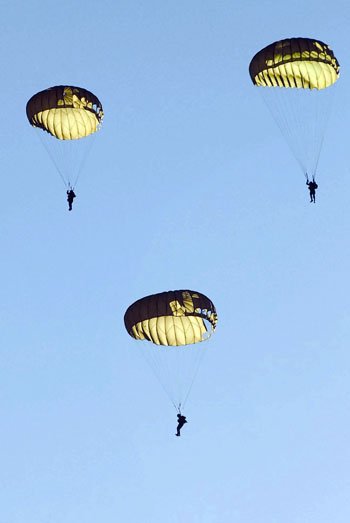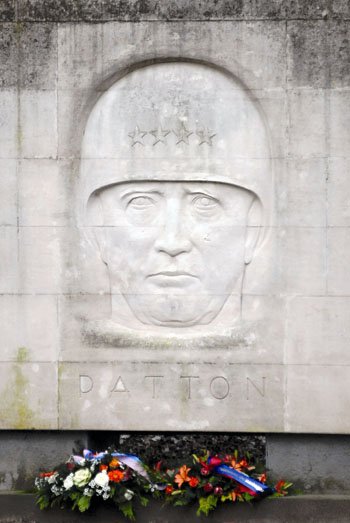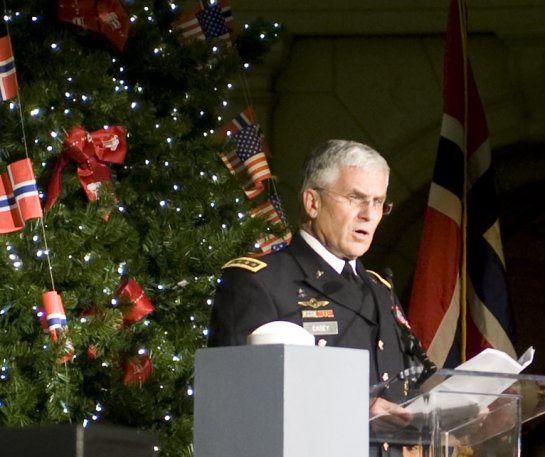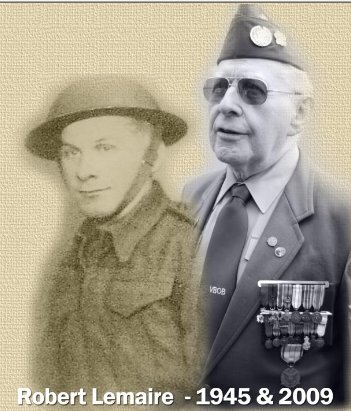« Obama and Barney Frank Financial Regulation Plan~ Hurts Small Businesses | Main | Sarah Palin Makes Surprise Appearance on 'Tonight Show' »
December 12, 2009
Bastogne To Mark 65 Years


Battle of the Bulge commemoration takes on special significance this year
The annual Battle of the Bulge commemoration in Bastogne, Belgium, starts Friday ( December 11th) .
There will be thousands of people, mostly Belgians, from attending the three-day event.
"The city is a very important place historically," said Belgian army Lt. Col. Henri Badot-Bertrand, commander of Heintz Caserne, the local garrison.
It’s historic because Bastogne has long been the focal point of the largest battle involving the U.S. Army and its commemoration. It was in Bastogne that elements of the 101st Airborne Division defended the city and a strategic crossroad despite being encircled by the German army. And it was here that Brig. Gen. Anthony McAuliffe defiantly rebuffed a German ultimatum to surrender.
The cellar where McAuliffe issued his legendary retort, "Ah, nuts," is on the Bastogne caserne. Though typically closed to visitors, the cellar’s small, modest museum will be open to the public 1-6 p.m. Friday and 8 a.m. to 6 p.m. Saturday and Sunday. Admission is free.
Heintz Caserne has been in the news this year because the Belgian military intends to soon close it and 22 others as part of a restructuring effort. That means this likely will be the last year a military unit calls Bastogne home.
Throughout the years, Bastogne has attracted many U.S. veterans of the battle, but with the passage of time fewer have been turning out each December. Only a handful, maybe a half-dozen at most, are expected to attend this year, event organizers said.
There are five main events planned. They involve a walk, wreath laying, a ceremonial nut toss, vintage vehicles and a re-enactment. Veterans of the 1944 battle, so named because of a bulge in the 80-mile front, will most likely attend the wreathing-laying events and the nut toss from the city hall balcony.
On Sunday afternoon, World War II-era vehicles will move in a convoy through Bastogne after a late-morning parachute drop near the Mardasson Memorial, situated on the outskirts of town.

Gen. George W. Casey Jr., chief of staff of the Army, reads the World War II Christmas letter from Gen. Anthony McAuliffe to his troops during the 13th annual Norwegian Tree Lighting Ceremony in Union Station, Washington D.C., Dec. 3, 2009. The tree is a gift from Norway and a symbol of the friendship between the United States and Norway.
Washington D.C.
The Army’s chief of staff stepped back in history Thursday evening to Christmas Eve in Belgium 65 years ago by reading one of the most inspirational letters written by a commander to his troops.
“What’s merry about all this, you ask? We’re fighting – it’s cold, we aren’t home,” Gen. George W. Casey read to onlookers at the annual Union Station Christmas tree lighting ceremony and tribute to the 99th Infantry Battalion, a Norwegian-American World War II unit which rescued 52 U.S. soldiers in Malmedy, Belgium.
“All true, but what has the proud Eagle Division accomplished with its worthy comrades, the 10th Armored Division, the 705th Tank Destroyer Battalion and all the rest?” Casey continued reading of the letter written by Brig. Gen. Anthony C. McAuliffe.
McAuliffe was acting commander of the 101st Airborne Division between Dec. 16, 1944 and Jan. 25, 1945, when he and more than 800,000 Allied troops found themselves in a raging battle in Bastogne, Belgium, and the surrounding area. The nearly six-week battle pitted slow-moving, massive German Tiger tanks against nearly twice as small, nimble American Shermans with significantly less firepower.
The outcome of the Battle of the Bulge -- the German army’s last offensive drive to split the Allies in the Ardennes -- ultimately determined who would be left standing at the end of World War II in Europe.
Casey continued reading McAuliffe’s letter to the troops, many of whom that winter were still wearing clothing from the June 6, 1944, D-Day landing on the beaches of Normandy, France.
A special guest at the lighting of the 32-foot fir, 87-year-old Jarvis Taylor was a heavy weapons 30-caliber machine gunner with the 99th Battalion. He recalled in a phone interview how it was a treat to occasionally get shuttled by a jeep behind the battle line for a shower.
“I know it was a great relief to a lot of us when there was a quiet spell where we’d get a chance to have showers, and usually they would give you a change of underwear and maybe socks, but you pretty much had to make do with the uniform you had,” he said.
Casey continued with the Christmas letter in which McAuliffe talked about how the Allies had stopped the German advance, though he had conceded that the Germans had surrounded the Allies while “their radios blared our doom. Their commander demanded our surrender in the following impudent arrogance,” Casey read.
The German commander’s Dec. 22 letter to McAuliffe described how “the fortune of war was changing,” how the American forces were encircled and that there was only one way in which McAuliffe could save his troops from “total annihilation”… through “honorable surrender.” McAuliffe was given two hours to respond.
McAuliffe’s four-letter reply to the German commander: “NUTS!”
.
Belgians recall protecting their soil 65 years ago during Battle of Bulge

Robert Lemaire was one of the few Belgian Soldiers who fought in the Battle of the Bulge. The Belgian Army surrendered to the Germans in 1940, but was re-activated in 1944. Lemaire joined the 5th Belgian Fusiliers Battalion, which was made up of six companies from the Mons, Tournai and Charleroi regions.
BENELUX, Belgium -- It was the early days of the Battle of the Bulge. Germans were advancing into Belgium, and the supplies they needed to strengthen their force were close at hand, until the bravery of a lone rifle company helped halt their advance.
On Dec. 18, 1944, in the Belgian town of Stavelot, “The U.S. Army evacuated the city, and the 5th Battalion was the only one between this treasure and the Germans,” recalled Robert Lemaire, a Belgian soldier who was assigned to the company.
The day prior, German Col. Joachim Peiper and his 1st SS Panzer Regiment were quickly moving through Belgian villages destined to reach the Meuse River and Allied supply ports in Antwerp. His Army plowed through towns like Honsfeld and Büllingen, capturing and killing unarmed Americans.
While the SS Regiment faced casualties and lost tanks and vehicles along the way, Peiper moved them on toward Stavelot. His tanks crossed the only bridge leading into the village and launched a morning attack, capturing the city. Lemaire, who was guarding the American fuel depots while his company was attached to the First U.S. Army, recalled that Peiper executed 132 civilians in Stavelot, including numerous children.
Americans repositioned their forces to set up a perimeter defense. However, Lemaire’s company was left behind along the Malmedy road.
“In a hurry, packed in a truck,” he recalled, “we left our billets in direction of the depot. As we came closer, our lieutenant asked for 10 volunteers.”
Lemaire was among the first to jump off the truck, along with Sgts. Harpigny, Magain, Vermeulen, Cpl. Suinen and fellow Pvts. Robert Delbois, Robert Tille, Alfred Cantigneau, Elomir Cambier, Jean Lesire, Paul Wantiez and F. Ingels. Their mission—to set fire to the fuel depot to prevent the SS from retrieving the supplies needed to rejuvenate their offensive.
“The lieutenant ordered us to set fire to the three first piles,” Lemaire recalled. “As the first attempt to shoot tracer bullets with a Bren gun failed, we then pierced jerry cans with our bayonets and spread fuel on the three first piles, as well as, a trail of fuel on the road ahead of the piles. We set the fire with matches.”
Within moments, the entire depot was engulfed in a trail of flames, stretching seven miles long. “It was impossible for the armored tanks to go through this wall of fire,” said Lemaire.
According to the Office of the Chief of Military History, as the gasoline roadblock was still enflamed, the Americans launched a full-fledged ground and air assault against the Panzer unit, reclaiming the town.
Engineers had destroyed the Amblève Bridge that would have allowed the Germans to retreat to their fuel depots to the east, and Lemaire and his company had destroyed the fuel supplies in Stavelot, preventing Peiper from advancing much further.
“We began to realize that we had insufficient gasoline to cross the bridge west of Stoumont,” Peiper said in January 1945, as reported by the Office of the Chief of Military History. The German powerhouse of heavy vehicles became meager road debris inefficient against the Allied forces. On Christmas Eve, the regiment was forced to abandon its vehicles and continue the battle on foot.
At the time, Lemaire didn’t realize the impact that striking a match would have on defeating the Germans. “We just did our job,” he said. It was a job that he had waited four years to accomplish.
Lemaire and a fellow Soldier, Marcel D’Haese, began fighting the Germans in 1940. The Belgian Army had surrendered that year, and the Germans put out an order that all young men were to report to Germany as laborers. Therefore, D'Haese said the Belgians made the choice to start a resistance.
“At the beginning of the war, I received an obligation to go to Germany,” said Lemaire, “so I became a resistance fighter.”
“The resistance was really active in Belgium,” said D’Haese. “We were doing sabotage to the Germans, like cutting the communications lines.” But despite their heroic actions to defend their nation and “four dark years of underground fight and suffering”, D’Haese said, “We waited and we prayed for the Americans.”
“Americans brought power, engines and weapons. They were like God to us. They were the only ones that could help to liberate us,” he said.
After the Alliance jumped into Normandy and later liberated Belgium, the Belgian government called for volunteers. D’Haese said 53,000 men answered that call and joined the newly-formed Belgian Army.
D’Haese and Lemaire joined the 5th Belgian Fusiliers Battalion, which was made up of six companies from the Mons, Tournai and Charleroi regions. D’Haese, who is now 84, was assigned to the Headquarters Company and Lemaire, who is now 86, the 3rd Company.
The unit was officially activated on Oct. 7, 1944, and the volunteers, who had already been defending their country unofficially, enlisted on Oct. 9.
After two months of training in Charleroi, they joined the First U.S. Army and deployed to the Ardennes where the battalion was divided amongst the American forces. The battalion had 800 men dispersed over 30 miles, according to D’Haese.
“They call us war volunteers. Indeed, we are freedom volunteers,” stressed D’Haese.” We were sick about war. We helped the Americans to finish it. We were ready to do anything we could for the Americans.”
“If the U.S. did not liberate Belgium, the Germans would still be here,” he added.
The 5th Fusilier partnered with the First U.S. Army until June 1, 1945. Throughout the war, five members of the battalion were killed and 80 more injured.
The unit and its actions were recognized by Gen. Dwight D. Eisenhower, the supreme commander, on July 13, 1945, in a memo that stated: “This battalion contributed materially to the successful operations of the unit with which it served. The high Esprit de Corps and great determination displayed by the officers and men of the Fifth Belgian Fusilier Battalion enabled it to carry through to a successful conclusion each and every assigned mission, thereby contributing immeasurably to the glorious victory of the Allied Nations. The outstanding achievements of this battalion bring credit not only to itself but also to the Belgian Army.”
Since that time, many other Americans have recognized the accomplishments of the 5th Fusilier, including U.S. presidents, senators, ambassadors, generals and the U.S. Army Garrison Benelux.
The unit established the 5th Fusilier War Veterans Association in 1945, and D’Haese has served as the chairman since 1980.
“I accepted the role as chairman for six months, and I’m still here,” he laughed.
The veterans join the USAG Benelux color guard on a regular basis to commemorate the American-Belgian partnership that was formed 65 years ago, but that partnership is slowly fading.
“We have 40-50 members left in the battalion,” said D’Haese, “but less than 10 are able to participate in ceremonies.”
In May, a small group remembered the anniversary of Victory in Europe Day in Mons.
On Dec. 12, a few make the annual trip to Bastogne to pay tribute again to the cold, smog-filled days of December 1944 and the allegiance with the Americans that brought liberty to their nation.
“God bless the U.S.A. and Belgium,” said D’Haese.
.

Wild Thing's comment............
Heroes all, their bravery, their courage, and their sacrifice. They held out under extraordinarily grueling conditions.
 .... Thank you Jim for sending this to me.
.... Thank you Jim for sending this to me.
Posted by Wild Thing at December 12, 2009 04:50 AM
Comments
We will never forget what the greatest generation did for the world in WWII. All heroes and unafraid to take on the enemy and WIN. Unlike today.
As for General Casey, my opinion of him are so full of expletives that this blog would self destruct if I posted them.
GO ARMY BEAT navy!
Posted by: cuchieddie(Enemy of the State) at December 12, 2009 10:24 AM
Blessed to have visited this sacred site in the 80's while at SPangdahlem Air Base in West Germany. You mean FDR didn't let the news media broadcast our troop movements and deployments over the BBC like CNN and FOX do today? Imagine that?
Posted by: darthcrUSAderworldtour07 at December 12, 2009 12:23 PM
The Battle of the Bulge was like a WWI battle in it's bloodletting. So many casualties. All to satisfy the desperate ego of Hitler.
The 101st Airborne is famous for it's stand at Bastogne, but actually there were a lot of pockets of American resistance that held out until overwhelmed. They all contributed to the slowing down of the German onslaught until reinforcements began to push the Germans back.
cuchieddie - I agree with you about Gen. "Diversity" Casey.
Posted by: TomR at December 12, 2009 01:34 PM
I look at General Casey and have thoughts about Colin Powell in that command bunker at the 23rd Division in '68. Then picture that train conductor punching the ticket as he boards the Pentagon Express. Neither of whom are fit to polish the boots of real officers.
OATH KEEPERS: ORDERS WE WILL NOT OBEY
1. We will NOT obey orders to disarm the American people.
2. We will NOT obey orders to conduct warrantless searches of the American people
3. We will NOT obey orders to detain American citizens as “unlawful enemy combatants” or to subject them to military tribunal.
4. We will NOT obey orders to impose martial law or a “state of emergency” on a state.
5. We will NOT obey orders to invade and subjugate any state that asserts its sovereignty.
6. We will NOT obey any order to blockade American cities, thus turning them into giant concentration camps.
7. We will NOT obey any order to force American citizens into any form of detention camps under any pretext.
8. We will NOT obey orders to assist or support the use of any foreign troops on U.S. soil against the American people to “keep the peace” or to “maintain control.”
9. We will NOT obey any orders to confiscate the property of the American people, including food and other essential supplies.
10.We will NOT obey any orders which infringe on the right of the people to free speech, to peaceably assemble, and to petition their government for a redress of grievances.
Posted by: Jack at December 12, 2009 02:20 PM
I was in the Navy. I know how Military people talk under stress. I've always had the suspicion that what McAuliffe really said wasn't "nuts." It may have been four letters, though.
Posted by: CharlieSays at December 12, 2009 06:02 PM
Can you imagine Iraq or Afghanistan with the casualties of the 'Bulge' 89,000 total, 19000 KIA, almost 70,000 wounded, missing and Pow's. There would be riots in the streets, and obama would be on a slow boat back to Kenya.
Oh CuciEddie: maybe next year. Army 3, Navy 17 looks like Army didn't show up this year.
Posted by: Mark at December 12, 2009 06:23 PM
Ditto about Casey.
Thanks everyone.
Posted by: Wild Thing at December 13, 2009 01:09 AM
